If You’re Looking for Tough Knives for the Kitchen Made in Germany, this guide is a Good Place to Start.
German knives are great options for a workhorse in the kitchen. When you want to cut up any kind of squash or melon or break down a large cut of meat that still has bone in it, a German style of knife is a great way to go. We have tested many German made chef knives over the years, so we figured it was time to choose our favorites.
If you think you are more of a Japanese knife fan, check out our article on the Top Japanese Knife Sets
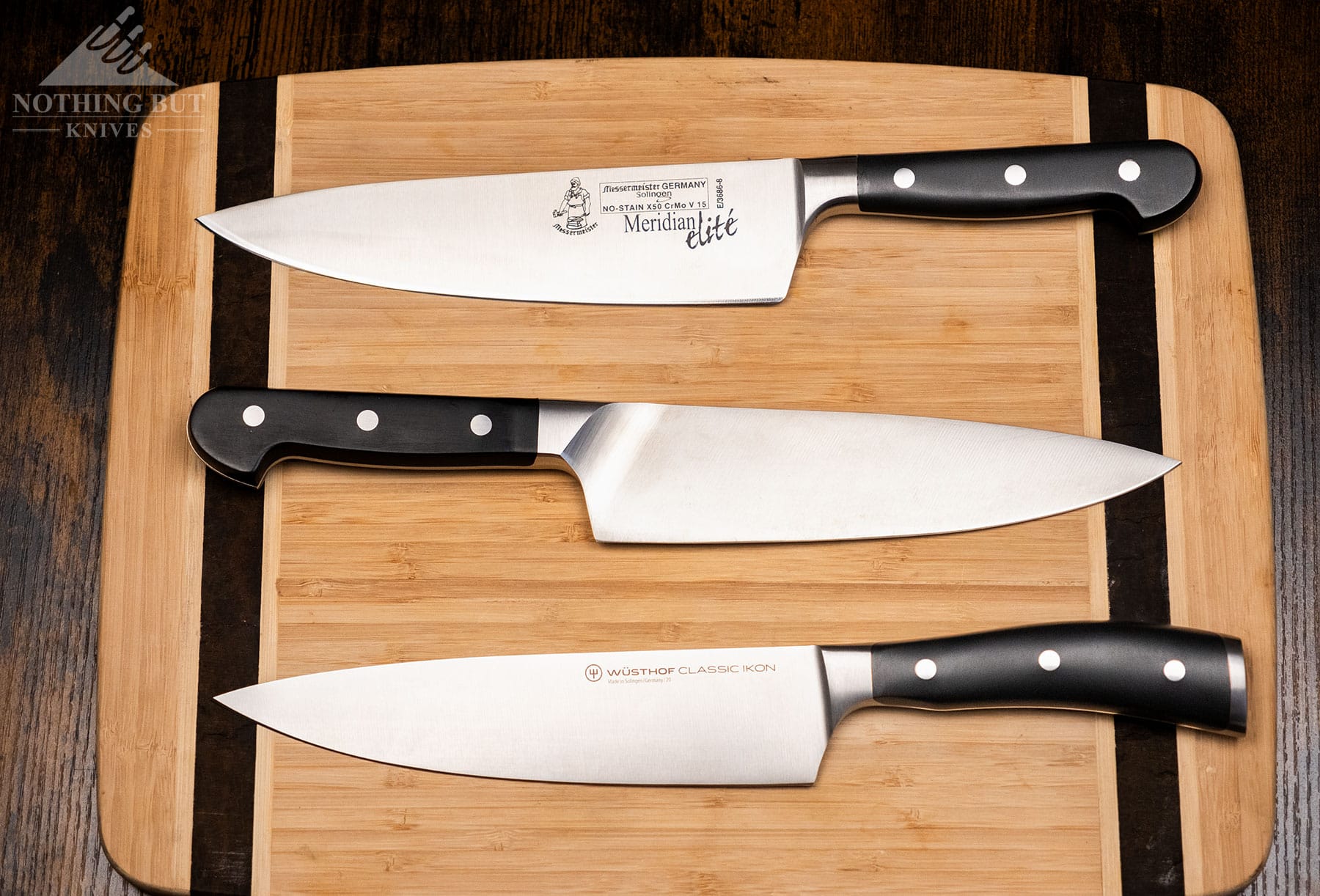
You might have some questions about the what, where, and why with German knives. We’ve tried laying out the essential information at the end of the article, but for starters here are some quick reasons to get a German-style chef’s knife:
Four Reasons to Use a German Chef Knife
- They’re tougher and easier to maintain;
- They tend to be cheaper;
- If you like rock chopping, you’ll like German knives;
- And the handles are usually bigger.
Our Four Favorite Chef’s Knives Made in Germany
These are all German-style knives made in Germany (mostly in Solingen). We only point that out because not only are there German-style knives made in other countries, but some of the German knife companies features in this guide also manufacture in other countries.
But this guide is all about knives made entirely in Germany.
Zwilling Pro – Best Overall
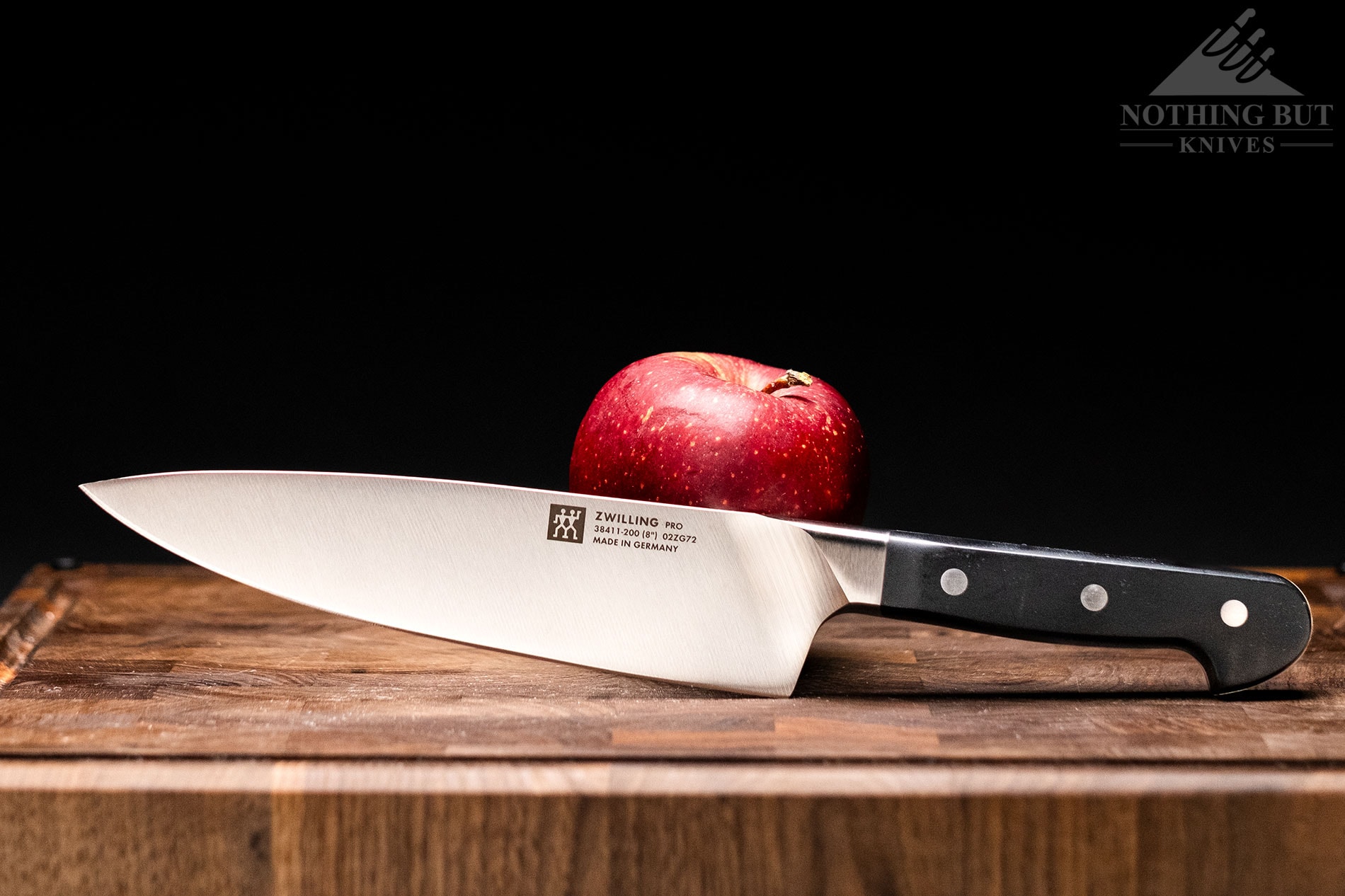
| Stand Out Features | Details |
|---|---|
| Good cutting performance | Made in Germany |
| Classic example of a German knife | Friodur stainless steel |
| Semi bolster, sloped | POM handle material |
| Balance favors the handle slightly | 266 g (9.4 oz) |
This is the most classic recommendation. Any time I review a western-style kitchen knife, I tend to use the Zwilling Pro as a measuring standard for weight, comfort, and cutting performance.
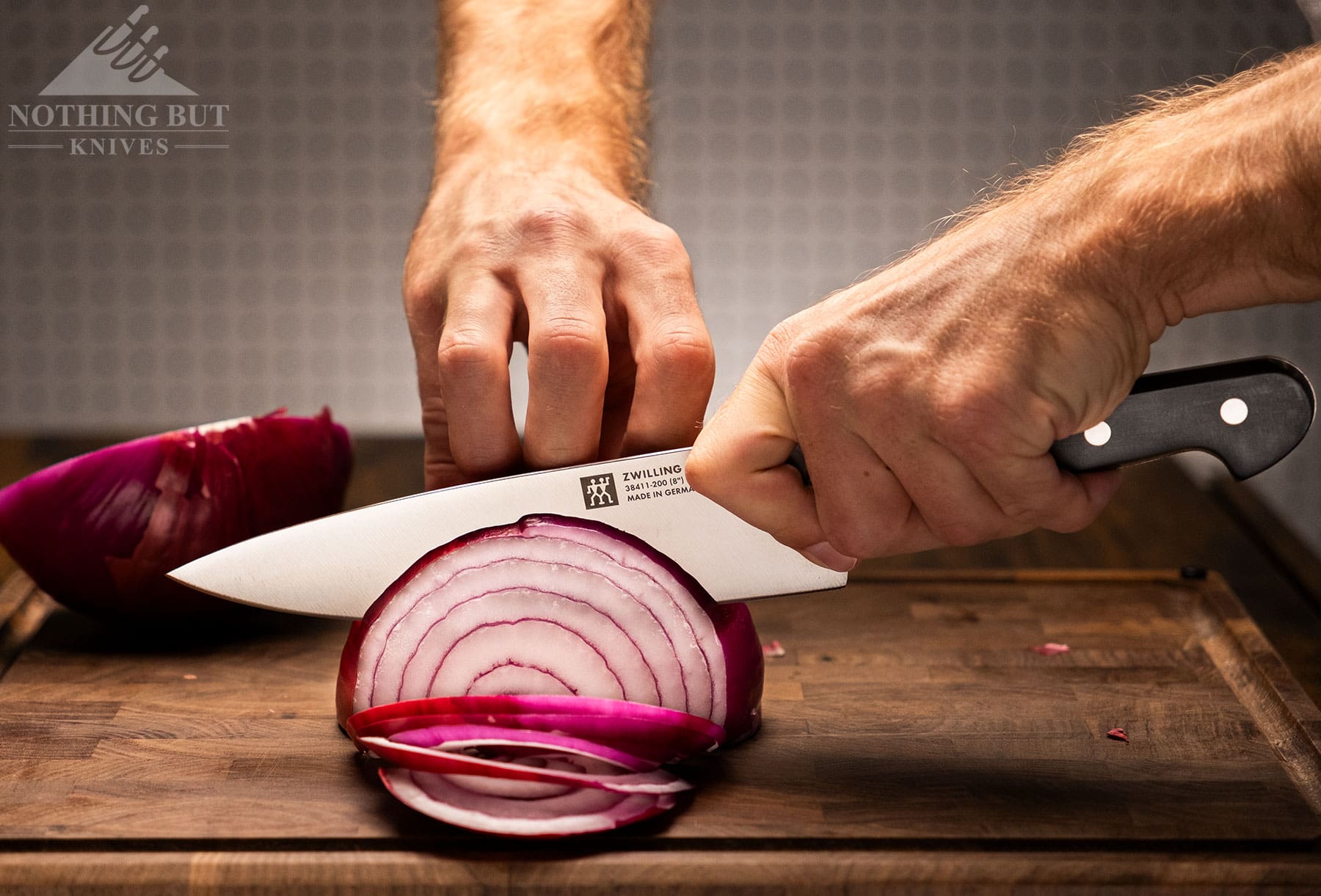
It has a big-bellied edge, it has a boxy western handle with a pronounced pommel, and, critically, it has a semi bolster that’s sloped and angled for an easy pinch grip.
The steel might actually be more stable than the average German knife, though. Zwilling has a proprietary method for treating their version of 1.4116 steel called Friodur that seems to give the edge more stability and wear resistance without detracting much from toughness.
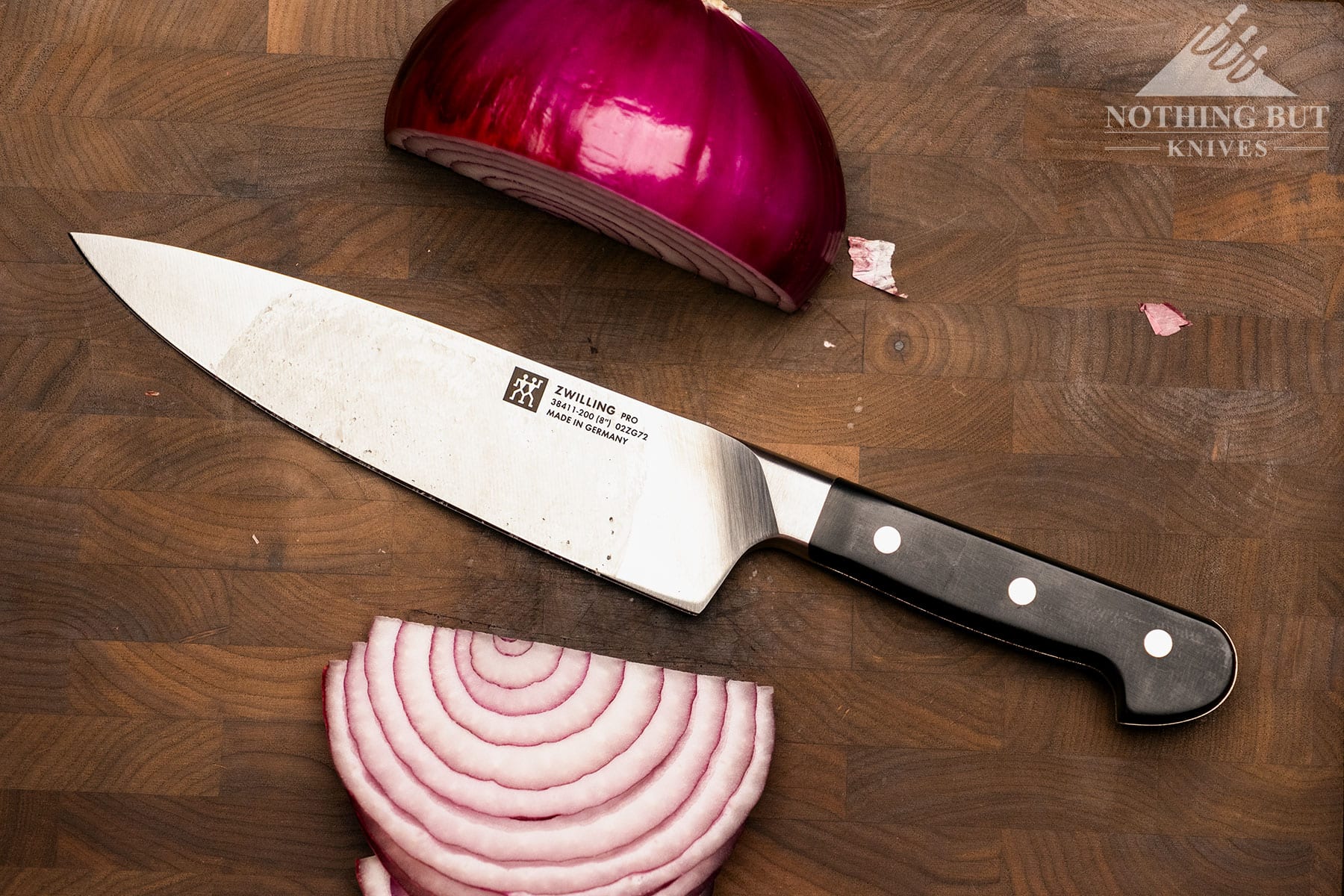
I won’t claim to know all the science behind it, but I know I like the way this knife cuts and ages better than a lot of knives in the same style.
If you’d like to get a run down of Zwilling as a company, you can read our guide here.
Or if you want to check out the full bolster version of this (for some reason), check out our review of the Zwilling Pro S.
Wusthof Classic Ikon – Most Comfortable Handle
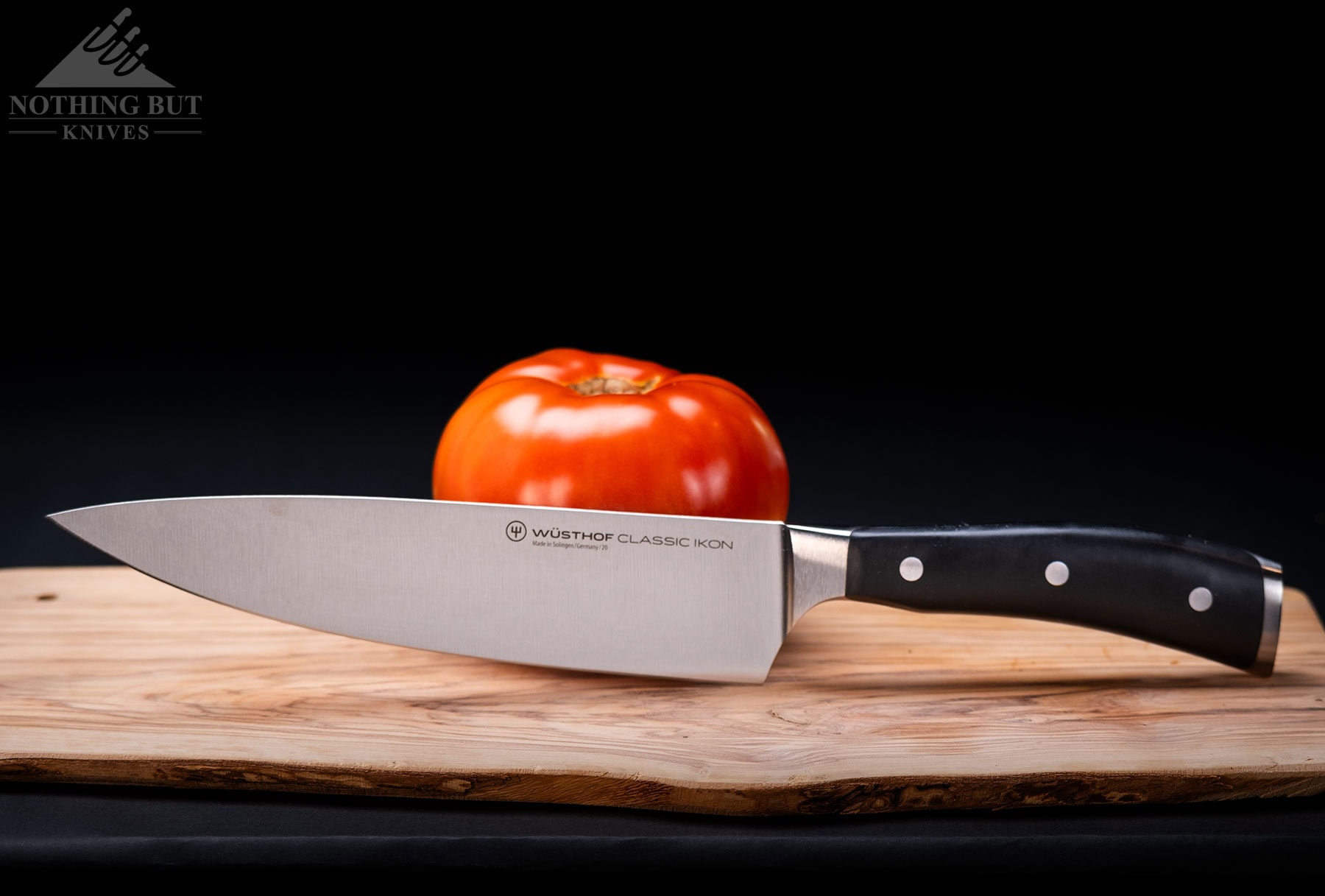
| Stand Out Features | Details |
|---|---|
| Decent cutting performance | Made in Germany |
| Rounded handle | X50CrMoV15 stainless steel |
| Semi bolster | POM handle material |
| Balance heavily favors handle | 273 g (9.6 oz) |
This is the knife to get if you want a lot of weight balanced toward the handle. It’s not the highest performing cutter out of the box, but it gets the job done well enough.
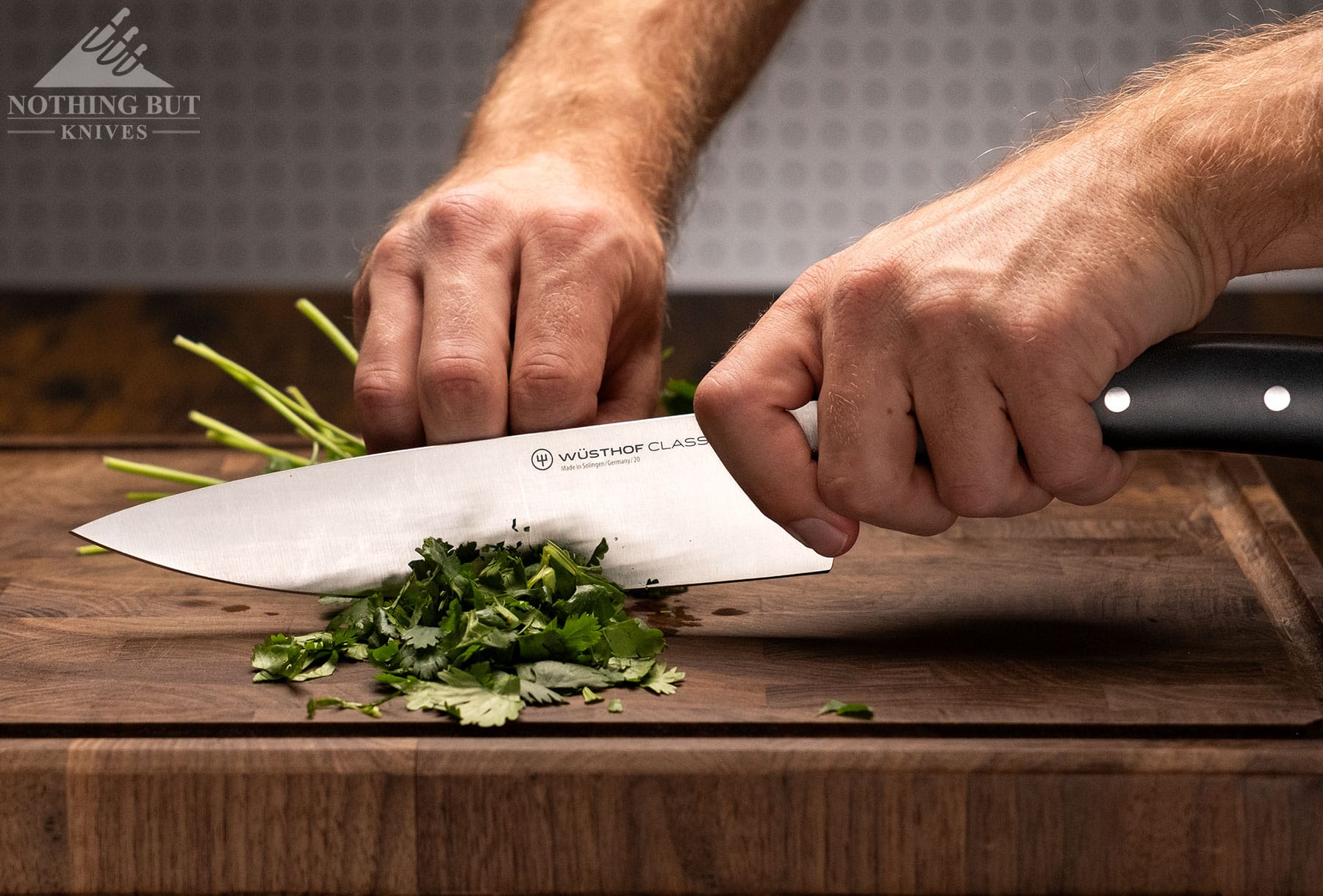
The Wusthof Classic Ikon is all about the handle. It curves inward, it’s rounded, and it’s heavily balanced toward the pommel. That gives the Ikon a strangely soft and nimble feeling. I say “strangely”, because it’s also a heavy knife; it’s just that the handle weight makes the blade feel more nimble.
The blade is decent. It doesn’t have a very aggressive bite, but it’s sturdy, and the edge is pretty easy to sharpen up. I’d put it’s out-of-the-box performance a step below the Zwilling Pro, but it’s plenty sharp enough for rough chopping onions and potatoes.
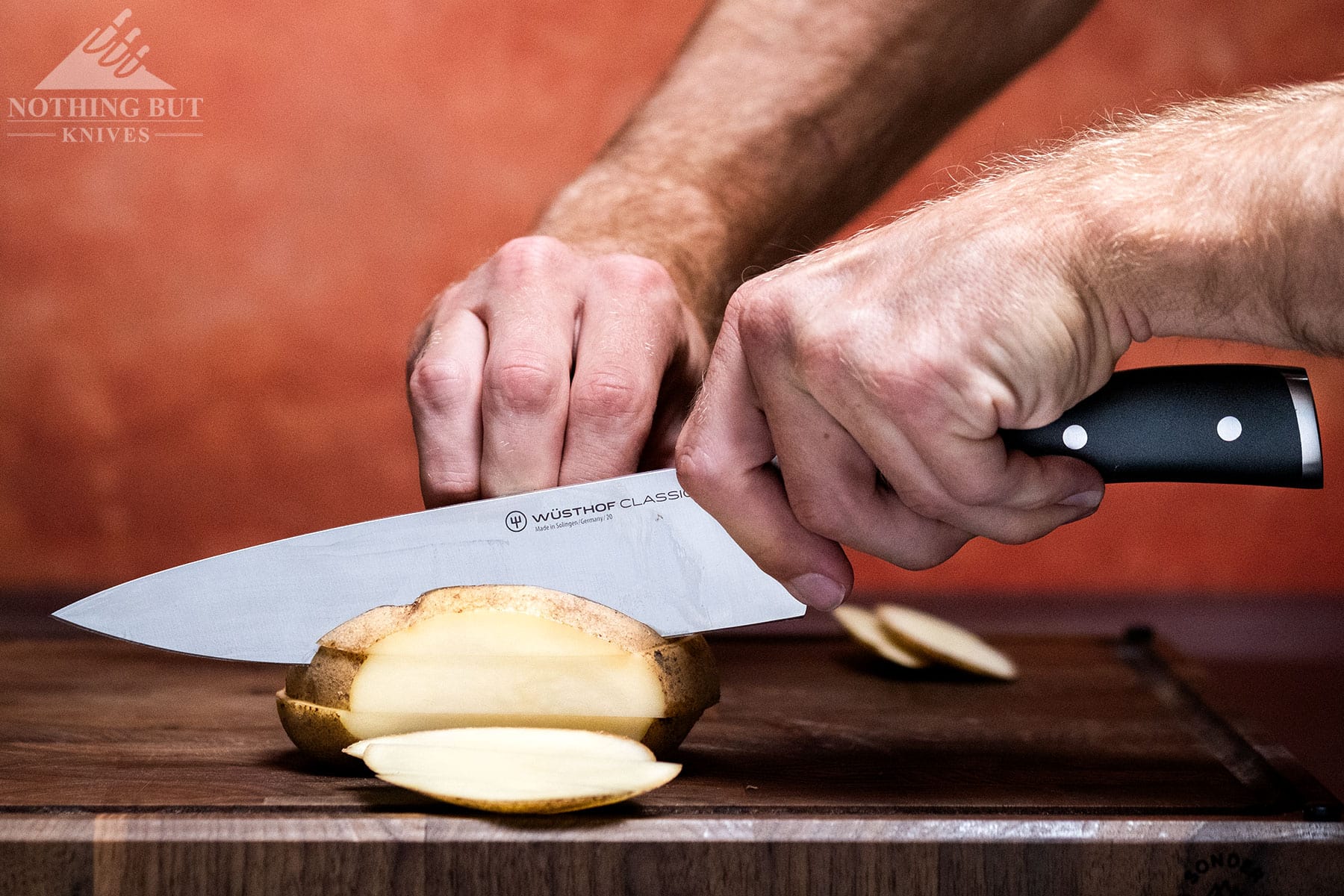
Because of the handle weight, rock chopping feels really nice. So it also does a good job with mincing herbs almost entirely by virtue of how easy the motions feel with the Ikon. Still, I’d recommend stropping it a little if you want a really good time.
Check out the full review of the Wusthof Classic Ikon here.
Messermeister Meridian Elite
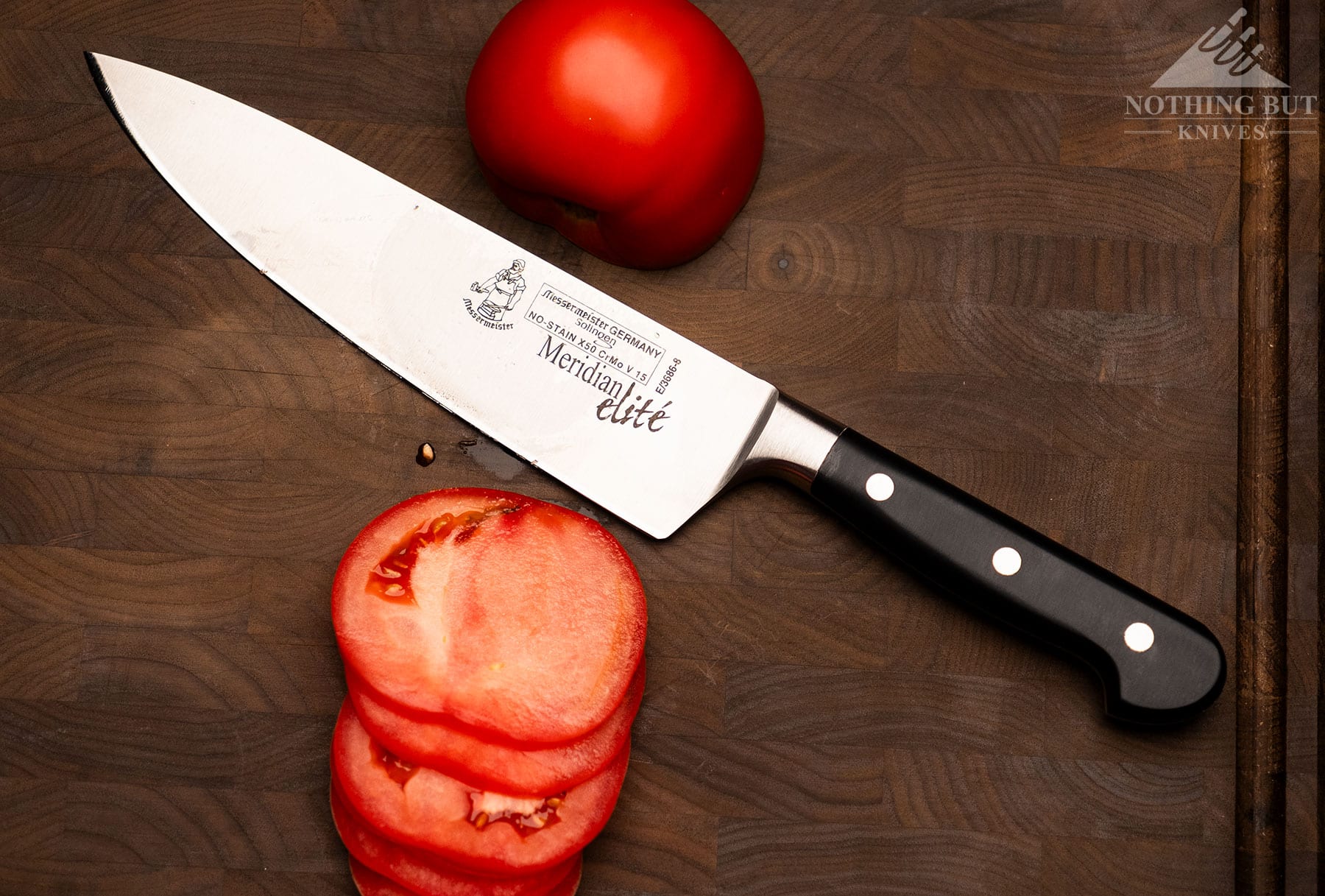
| Stand Out Features | Details |
|---|---|
| Okay cutting performance | Made in Germany |
| Rounded handle | X50CrMoV15 stainless steel |
| Semi bolster | POM handle |
| Balance favors the blade | 281 g (9.9 oz) |
| Thicker blade than usual |
Messermeister is actually a California based company, but the Meridian Elite series is still made in Germany, and style-wise is pure western kitchen knife
This is one of the only knives on this list currently that feels a little bit weighted toward the blade. That’s probably thanks to the fact that the blade stock is a bit thicker than most other kitchen knives in general.
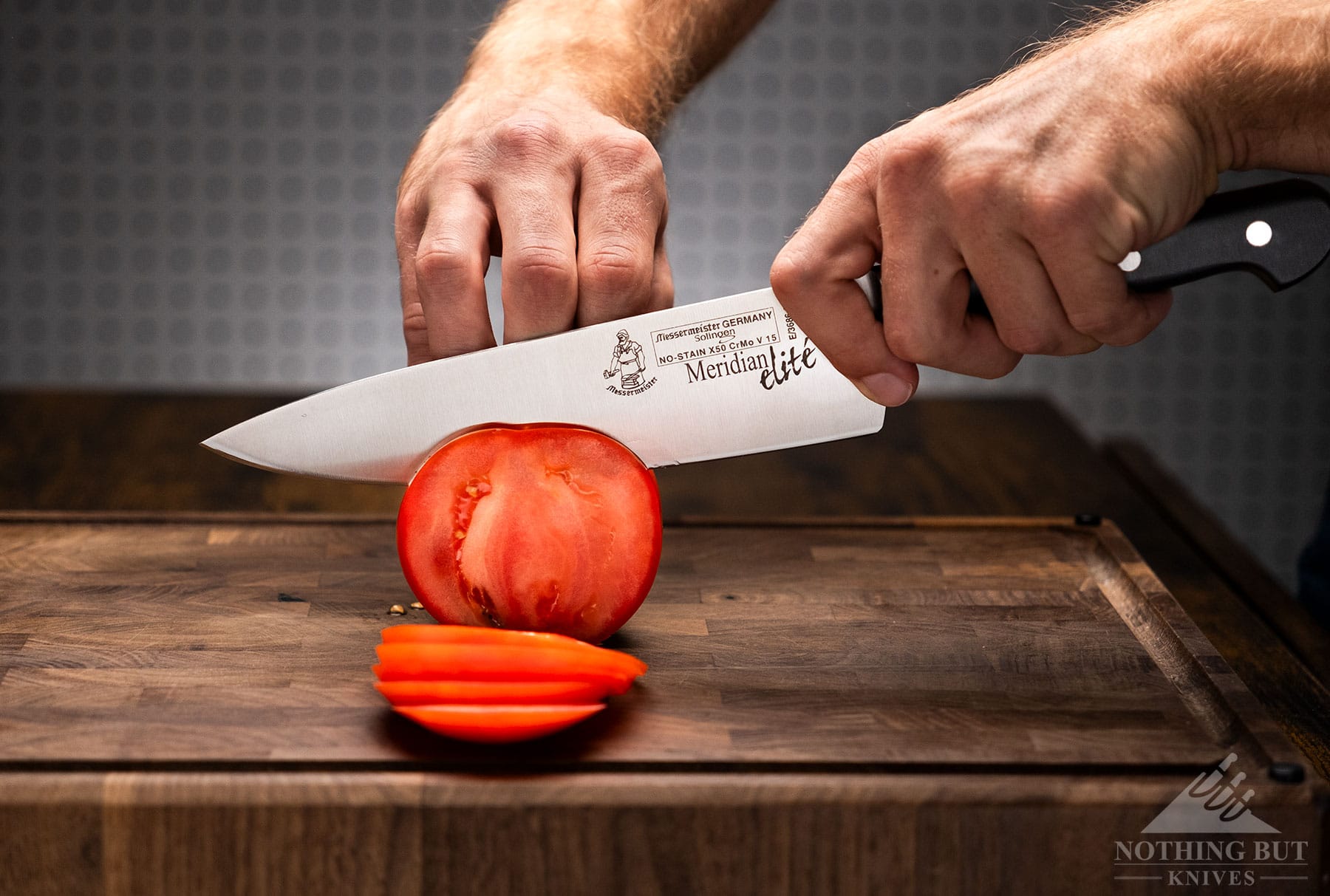
That thickness definitely shows up in the cutting performance. It feels a little clunkier than even the Wusthof Ikon, so I wouldn’t put this forward as the high-performing option, except in that the weight does actually help make cuts easier. In a list full of kitchen knives built for a certain degree of tough kitchen work, I’d probably put the Meridian Elite forward as the toughest option.
The handle is also nicely rounded, so there are fewer hot spots. The spine is the only part of the knife that I ever feel biting into my hand. Personally, I think it’s more comfortable than the Wusthof Ikon.
One more little point worth mentioning is that this knife gets listed now with 1.4116 steel. The one we tested is from several years ago and has X50CrMoV15 steel stamped on the blade. I don’t know when or why they made the switch, but the two steels are essentially the same, so I doubt there’s much difference in longevity.
Gude Alpha Series
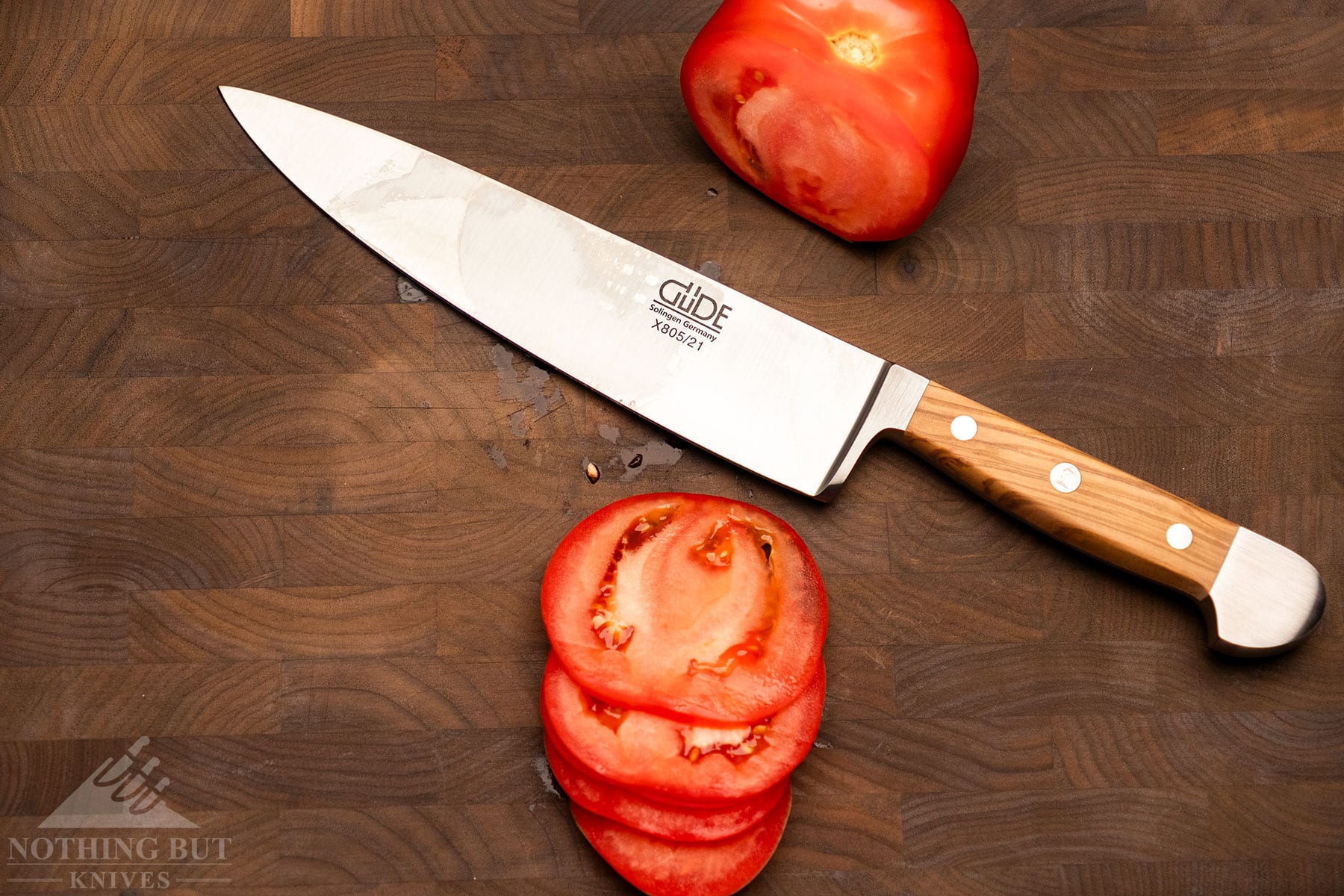
| Stand out Features | Details |
|---|---|
| Toothy edge | Made in Germany |
| Wide handle | German stainless steel |
| Full bolster | Olive wood |
| Balance heavily favors handle | 306 g (10.8 oz) |
Currently the heaviest knife we’re featuring on this list, Gude’s Alpha series is a beast of a cutter. It’s far from being optimized for precision, though. It’s an aggressive cutter between the weight and the toothy edge, so a lot of things will feel easier to cut initially with it, but it’s thick and has a toothier edge than usual for a kitchen knife.
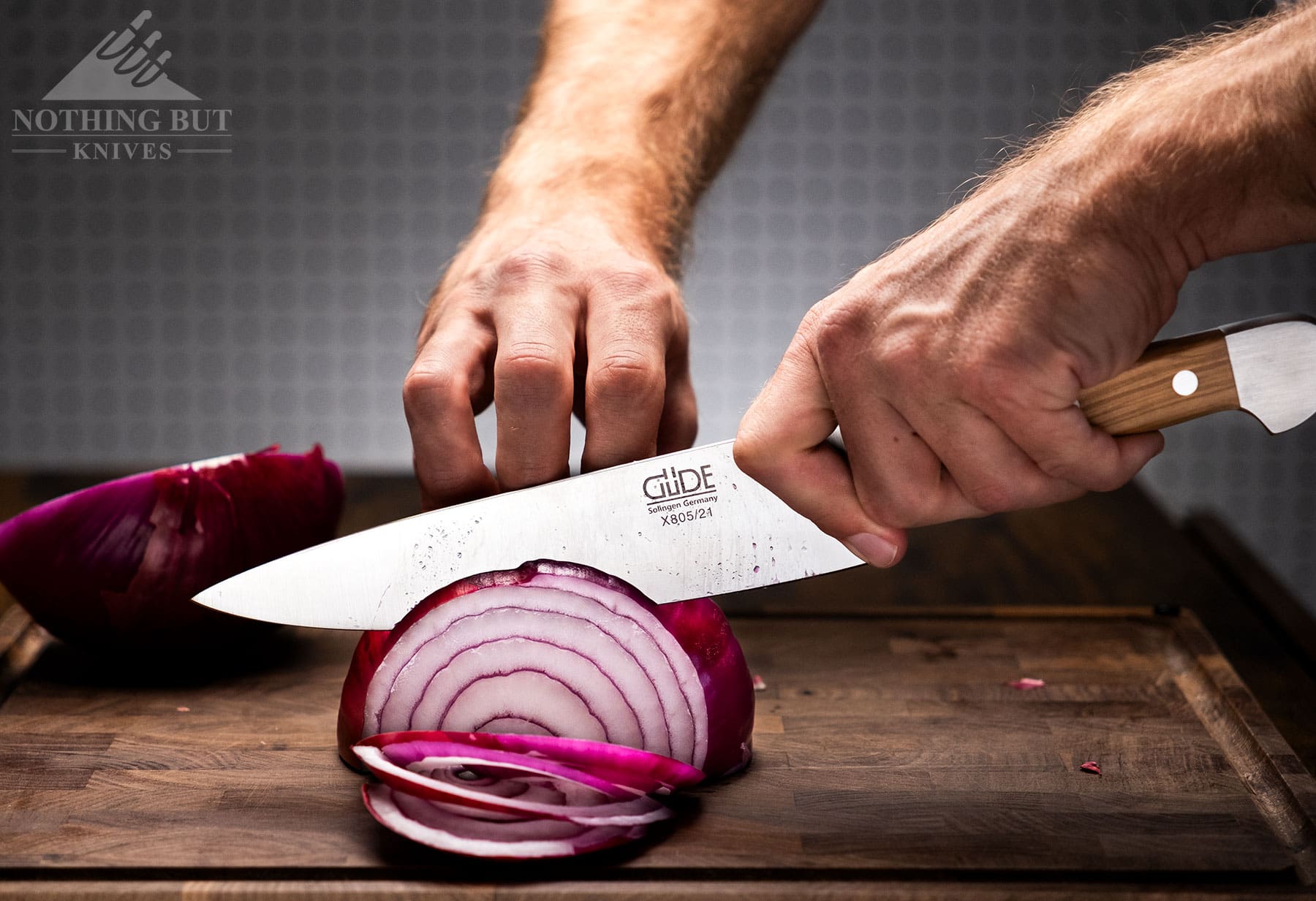
While I’m not a fan of the full bolster, I appreciate that they’ve angle it away from the cutting edge. That should increase the amount of sharpenings this knife has before you need to have the whole bolster ground back.
The handle is wide and a little boxy, but the edges are just rounded enough that it doesn’t bite into the hand when you tighten your grip. It’s probably a good option for people with larger hands.
They tend to list the steel as “a piece of high carbon chrome vanadium molybdenum steel”, which could be a lot of steels out there, but in context I don’t see any reason to think it’s anything other than X50CrMoV15, or a variation of it.
We spent a few weeks testing out the Gude Alpha 8-inch chef knife for an in-depth review that is worth a look if you want to learn more.
German Manufactured Chef Knife FAQ and Helpful Info
There’s a lot of cutlery history in Germany. There are also a surprising number of things to know and get confused about on a tool that is just a sharp piece of steel sandwiched between two pieces of plastic most of the time.
What actually is a German Style Knife?
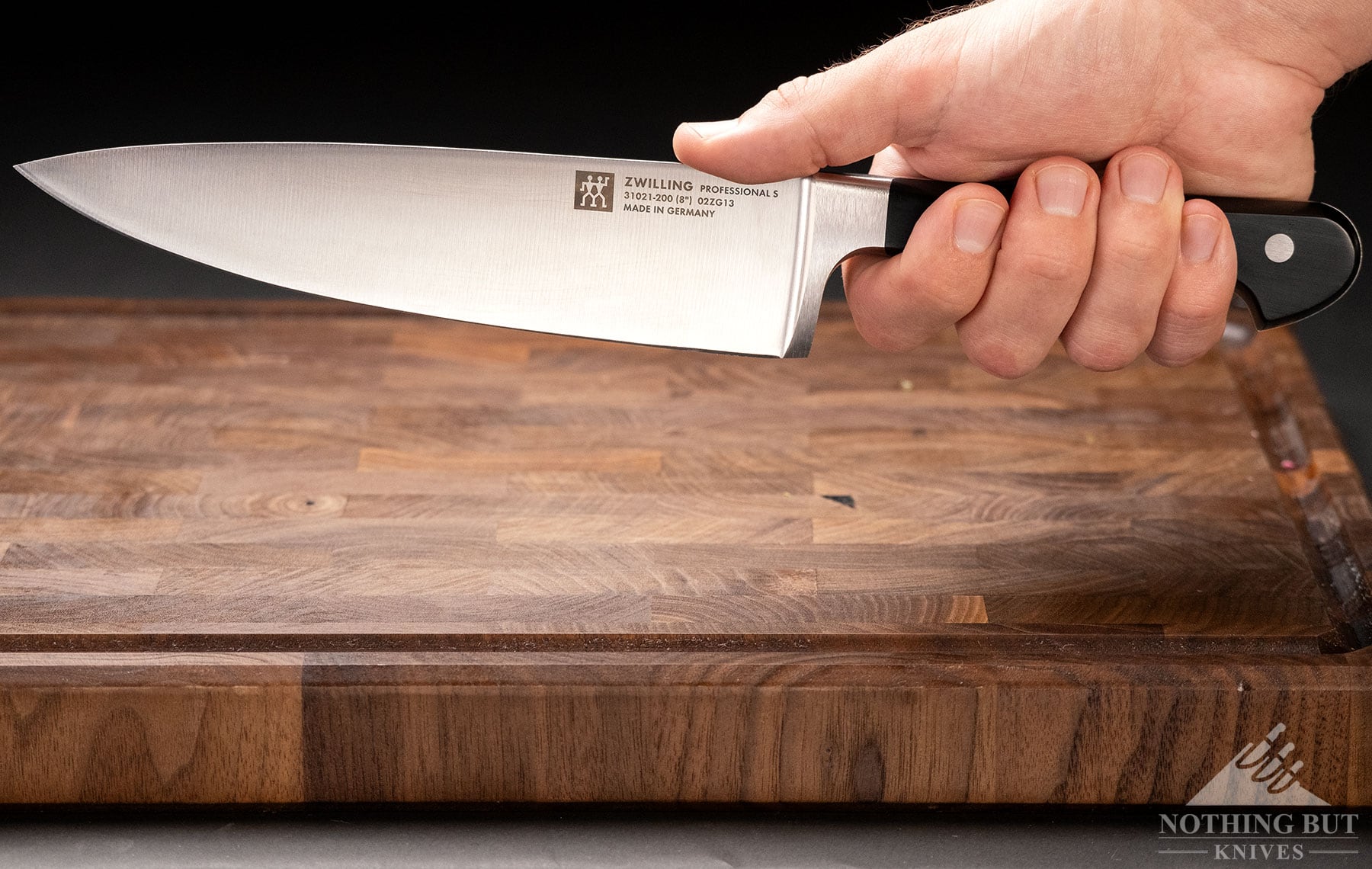
Traditionally a German chef’s knife has a thicker spine and a large belly in the edge. But it’ll be easier to ingest in list form.
Typical German Knife Characteristics:
- Tall blade (about 2”) with a curved edge;
- Tip of the blade is often oriented closer to the spine;
- Usually has a thicker blade stock;
- Meant for rock chopping motions;
- Softer, tougher steel as it’s supposed to be able separate bones and cut large hard foods;
- Full bolsters (not on all of them, but some, and you definitely won’t see that on a Japanese knife).
The difference between a German chef’s knife, a French sabatier, and a Japanese gyuto are mostly in the blade thickness and geometry in the tip.
A sabatier knife will have a slimmer profile, a straighter cutting edge with a tip more centered with the blade almost like a spear point.
The Japanese gyuto (which actually started as a French design) will be similarly slim, but the tip is often oriented forward toward the edge and is usually thinner with harder steel as it’s meant for precision cutting.
Why a German knife?
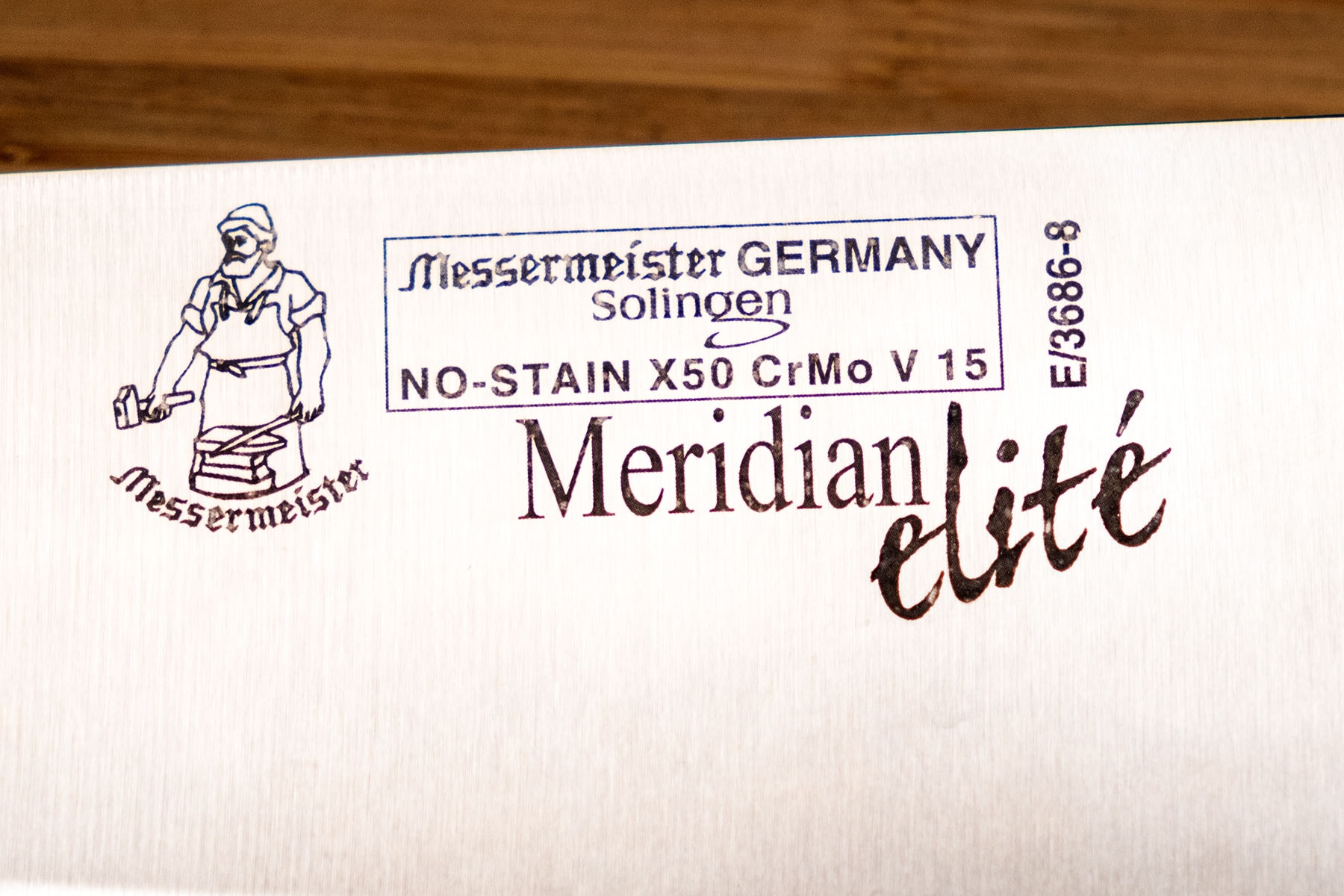
These knives are meant for cutting up hardy foods into chunks. For separating bones and cracking melons and making soups and sausages and sacking Rome.
They are built to be tough rather than hard and thin.
They they can handle a lot more abuse (up to a point; these are still kitchen knives, not camping knives). Most kinds of Japanese and even French style knives don’t like dealing with think melon skins or bone joints.
They’re easier to maintain.
German knives usually have thicker grinds and softer steel (more on that later). That’s part of what makes them tough, but it also makes the edges easier to hone, polish, strop, and even reprofile.
Some people like to rock (chop).
If you like to cut by placing the edge on the board and lifting the handle to cut back and forth with the belly of the blade, German knives will be your jam. Their edges often have larger bellies specifically for this style of cutting. There are several great rock chopping tutorials on YouTube including this one.
The handles are also usually larger.
Even though a lot of Japanese knives have started adopting western style handles (see knives like the Tojiro DP) you will still usually have a better range of large-handle options in Western-style knives. Obviously not everyone wants or needs a larger handle, but if you keep trying fancy knife recommendations and always feel like your hand is about to cramp or the knife wants to slip out, it might be worth trying out a German knife.
German chef knives tend to be on the more premium side of the market from a quality and price standpoint. That is why we included a few German knife sets in our High-End Knife Set article.
Full bolster vs Semi Bolster?
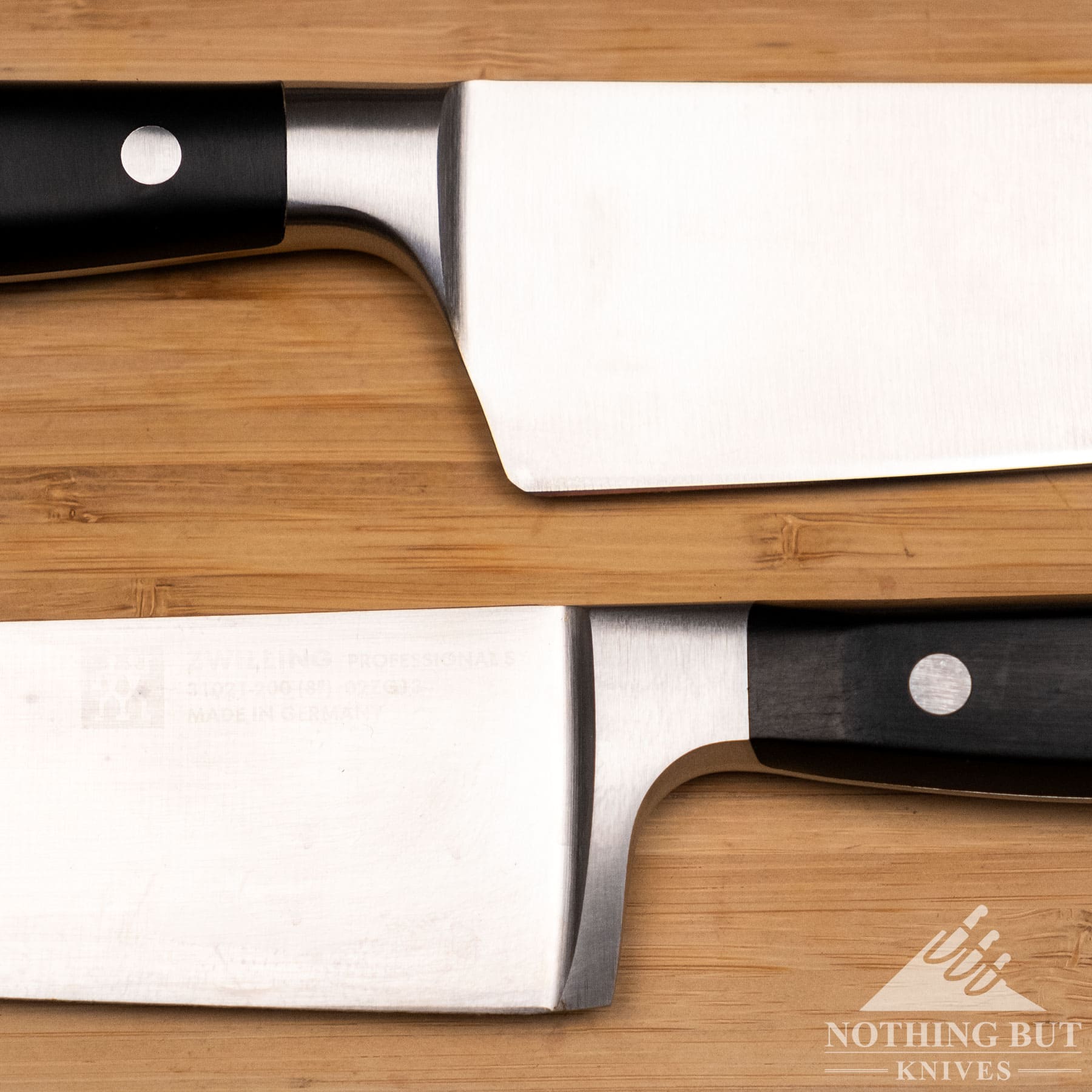
You do not need a bolster on your knife. Full stop.
But some people want one, so let’s get into it. First the definitions:
A full bolster is the chunk of steel that extends along the whole heel of a blade. Meaning from the top of the handle right up to the bottom of the edge.
A semi bolster is any piece at the top of the handle that doesn’t extend the whole heel, although usually ends up being a shaped piece about the same width as the handle.
There was a time when the full bolster was a sign of quality. It meant the knife had been forged in a certain way and was therefore (supposedly) tougher.
That’s not really the case any more. Put to extremes, a full bolster chef’s knife might out-tough a semi-bolster chef’s knife, but not in any activity you should be doing in the kitchen.
For most people, a full bolster is going to hinder more than help.
The Pros
- Shifts more weight into the hand
- Reduces risk of cutting yourself on the heel of the edge;
- Can be an ergonomic aid in some cases;
- Apparently, some people can use the lip of a bolster to open cans that have a tab opener.
The Cons
- The bolster will get in the way of sharpening the edge fully;
- It’s often a hotspot for pinch grips.
If you’re still leaning toward a full bolster knife, try to get one where the bolster has been ground away from the edge somewhat (like on the Lamson), and check your area for a local knife sharpener, because they’ll usually be able to grind the steel back once the edge has been sharpened behind the bolster.
Is German steel good?
Yes, but remember what it’s for: toughness and quick maintenance.
It’s a common misconception that harder steel is always better. The reality is that being harder makes blades more brittle. I wouldn’t want to touch a watermelon or a fully-boned chicken carcass with a 2 mm-thick gyuto running 64 HRc. That’s begging for a chipped edge.
But your Friodur, your 1.4116, and your X50Cr15MoV in the 58 – 60 HRc range all have the same benefit: the edge usually rolls before it chips, and you can fix that up easily with a honing steel.
So yes, German steels are fine. They aren’t great if you want great edge retention, but if you want your knife to be able to survive harder foods, it’s not a bad way to go.
A Little About Anatomy and Technique
I threw around a lot of words like “sloped bolster” and “pinch grip” and “crowned spine” and didn’t want to the time or risk sounding like a condescending jerk and explain those terms when there were knives to talk about. So here’s a quick index explaining a few of those terms.
What’s a Pinch Grip?
Grab the blade of your knife with your thumb and index finger just under the spine and a little above the bolster. That’s a pinch grip. That’s how pretty much all professional cooks cut because (1) it makes the blade easier to control and (2) it aligns the blade with your arm.
When I review knives, it’s with this grip in mind 90% of the time, which is why sloped bolsters and crowned spines are so important.
The Bolster
I think the official definition of this is “the place where the blade communicates with the handle”. I usually just explain it by pointing at the little piece of metal set on top of the handle and say “that’s a bolster”.
Crowned Spine
This is when the spine of a knife is rounded so there it doesn’t have any hard edges. This is a beautiful thing to see on a knife for anyone who’s ever had to do a shift dicing onion for a couple hours. Nothing bites your finger like the hard edge on a spine.
Distal Taper
If you pick up the knife, turn it so the edge is away from you, and take a good look at the spine, you might notice it’s thicker at the base near the handle and thinner toward the tip.
That’s called the distal taper, and you want to see a pretty dramatic one on a German chef’s knife. The idea is for the blade to be thick and tough near the heel of the blade so it can handle more pressure and tougher tasks, while the tip is thin and light so you can use it for more delicate cuts.
Toothy vs Polished Edges
If you’ve ever been told a knife is super sharp then went to cut something smooth with it like an underripe tomato and found it had trouble starting the cut, you’ve experienced a highly polished edge.
The tooth-iness of an edge depends on the coarseness of what it was sharpened on. A 500 grit water stone will make a very toothy edge that will tear right through a tomato skin no matter what state of ripeness it’s in.
A 2,000 grit stone will get you a polished edge that will make much cleaner cuts and last longer.
Take a microscope to a knife’s edge, and you’ll see a line of spikes. Basically, all edges are serrated, it’s just on most the serrations are too small to see.
On a toothy edge, those serrations will be farther apart, and as a consequence will make larger (but still very tiny for the naked eye) tears in whatever you’re cutting. The closer those serrations get together during sharpening, the more polished the edge is, and smaller the tears become.
That’s why a polished edge is usually preferable in the kitchen. It lasts longer, and it’s gentler on the food you’re cutting.

Good afternoon, just happened to be browsing, I appreciate your details, people have often asked me, what is the best knife, my immediate response is, what ever fits your hand, I’m a professional chef and a professional event planner, and have been for almost 40 years. My pleasure to make your acquaintance, James
Glad you found us, James. Thanks for hanging out.